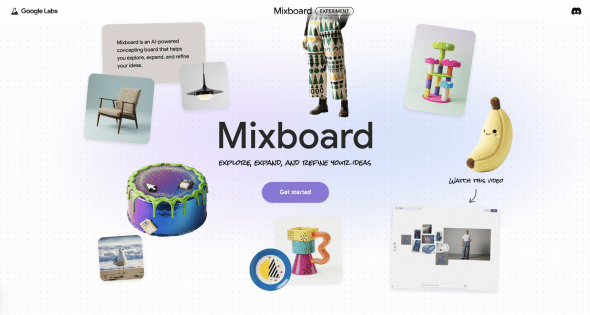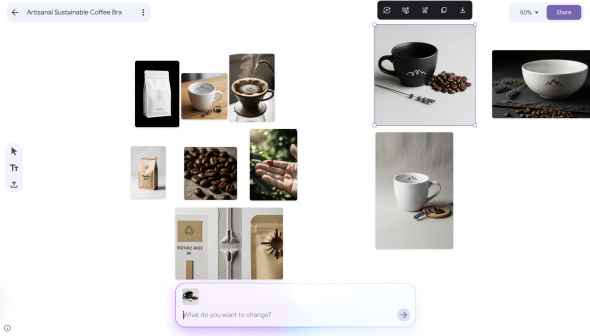Mixboard: Google’s New AI Tool for Creative Brainstorming
Mixboard is an AI-powered concepting board that helps users visually brainstorm and develop creative ideas. Developed by Google, the tool was announced in September 2025 as an experimental beta available through Google Labs, exclusively for users in the United States. As an experimental project from a major tech leader, it carries no specific funding information.
Mixboard is designed for a broad audience, from individuals planning personal projects to creative professionals in design and marketing. It solves the initial, often challenging, stage of the creative process: turning a rough idea into a tangible visual direction. The tool’s primary value proposition is its ability to generate, not just collect, visual concepts. It disrupts traditional methods like manual image sourcing and mood boarding by using generative AI to co-create ideas with the user in real-time, making brainstorming a more dynamic and interactive process.
Best Use Cases for Mixboard
- Brand Strategists and Marketers: A Brand Manager can use Mixboard to rapidly generate visual concepts for a new product launch. The tool helps translate abstract brand values into concrete imagery, color palettes, and taglines, which can then be used to storyboard a marketing campaign or design initial social media assets. It significantly speeds up the initial ideation phase before moving to high-fidelity design tools.
- Interior Designers and Homeowners: For anyone planning a home renovation or redecoration, Mixboard serves as a powerful digital sketchbook. It allows users to input a style like “mid-century modern coastal living room” and instantly receive a board filled with furniture ideas, color schemes, and decor elements. They can then use natural language to refine the images, for example, by asking to “make the sofa blue” or “add more plants.”
- Event Planners: Planning a wedding, corporate event, or party involves defining a theme and atmosphere. Mixboard can take a simple prompt like “rustic autumn wedding” and generate a complete concept board with floral arrangement ideas, table settings, invitation styles, and color palettes, providing a strong visual foundation to share with clients and vendors.
- Content Creators and Social Media Managers: When developing a new content series or aesthetic for an Instagram feed, creators can use Mixboard to explore different visual themes. It can generate a variety of flat lays, photo styles, and graphic design elements that align with a desired mood, helping to maintain a cohesive and visually appealing online presence.
AI-First Ideation: The application is built from the ground up for AI-powered brainstorming, making the process straightforward.
Direct Natural Language Editing: The "Nano Banana" model allows users to edit images with simple conversational commands, removing the need for technical design skills.
Fast Idea Exploration: The "regenerate" and "more like this" features enable quick iteration, allowing users to explore dozens of creative paths in minutes.
No Cost to Use: As a free experimental tool, it offers powerful generative capabilities without any financial commitment.
Reduces Creative Blocks: It serves as an excellent starting point for any project, providing instant visual inspiration to overcome the "blank page" problem.
Context-Aware Text: The tool can generate relevant captions and descriptions, adding another layer to the creative concepts.
Limited Availability: Currently restricted to users in the United States, which limits its accessibility.
Experimental Condition: As a beta product, it may produce inconsistent results or have functional bugs.
Not a Professional Design Tool: The tool is strictly for ideation and cannot be used for creating production-ready or high-resolution assets.
No Integrations: It is a standalone web app with no connections to other software suites like Adobe or Figma.
-
AI Board Generation: Starts the creative process by generating a full concept board from a single text prompt.
-
Natural Language Image Editing: Allows users to modify AI-generated images by typing conversational commands.
-
Iterative Creation Tools: Includes “regenerate” and “more like this” buttons to quickly explore variations of visual elements.
-
Contextual Text Generation: Automatically creates text snippets and captions that match the visual content on the board.
-
Image Uploads: Users can add their own images to the board to combine them with AI-generated content.
-
Color Palette Generation: Automatically extracts or suggests harmonious color palettes based on the images on the board.
-
Visual Element Variety: Generates a mix of images, text styles, and color swatches to create a complete mood board.
-
Simple User Interface: Features a clean, minimalist layout focused entirely on the creative canvas.
 Mixboard Homepage
Mixboard Homepage
 Mixboard Concept Board
Mixboard Concept Board
Frequently Asked Questions
-
What is Mixboard?
Mixboard is an experimental AI tool from Google that helps users brainstorm and create visual concept boards. -
Who is Mixboard for?
Mixboard targets a wide audience, including creative professionals, marketers, designers, and individuals working on personal projects. -
How much does Mixboard cost?
Mixboard is currently free to use as a public beta available through Google Labs. -
What are the main limitations of Mixboard?
Its primary limitations are its availability (U.S. only), its experimental nature, and its focus on ideation rather than professional design output. -
How is Mixboard different from Pinterest?
Pinterest is primarily a tool for curating and saving existing images, while Mixboard is a generative tool that creates new images and concepts based on user prompts.
Tech Pilot’s Verdict on Mixboard
I have spent time testing Google’s new experimental tool, Mixboard. My goal was to see if this ai concept board could assist with the early stages of a creative project. I decided to test it with a common task for our team: developing the initial branding concept for a fictional, eco-friendly coffee startup.
My first test was feeding it a simple prompt: “Branding concept for an artisanal, sustainable coffee brand with a minimalist aesthetic.” In less than a minute, the application populated a canvas with a coherent set of visuals. It gave me a logo concept, several product shots of coffee bags with earthy-toned packaging, lifestyle images, and a fitting color palette. The speed was notable. This initial step, which could easily take an hour of searching stock photo sites, was done in seconds.
Next, I tested the “Nano Banana” natural language editing feature. One of the generated images showed a coffee cup on a wooden table. I selected it and typed, “add a sprig of lavender next to the cup.” It processed for a moment and updated the image exactly as requested. The result was precise and demonstrated a useful capability. However, the feature has its limits. When I asked it to “change the logo on the cup to a stylized mountain range,” the result was distorted and unusable. This shows the tool’s current condition: useful for broad strokes, but not yet reliable for fine-tuned detail.
The pricing is a clear benefit. Being free, there’s no barrier to entry for anyone in the U.S. to start using it. The learning curve is minimal; if you can write a sentence, you can use the tool. The lack of integrations is a drawback. You can’t easily send your board to Figma or Adobe Illustrator. It is a closed-off tool for now, focused purely on that initial spark of inspiration.
Top Alternatives to Mixboard
-
Pinterest: Pinterest is a platform for visual discovery and curation. Unlike Mixboard, which generates new content, Pinterest helps you collect and organize existing images into mood boards. Its key strength is the volume of high-quality, human-curated content. It is a better choice when your goal is to gather real-world inspiration, rather than creating something new.
-
Adobe Firefly: Adobe Firefly offers generative AI features within a professional creative suite of tools. Its mood board functionality is more tightly connected with software like Photoshop and Illustrator, making it suitable for designers who need to move from concept to execution. Firefly is more capable of generating high-quality images but comes with the cost of a Creative Cloud subscription. Choose Firefly if you are a creative professional who needs a tool that fits into an established design workflow.
-
FigJam: FigJam is a collaborative online whiteboard from Figma, designed for team brainstorming. Its strengths are in structured activities like flowcharts and diagramming. While you can add images to a FigJam board, it has no native AI image generation capabilities. FigJam is the superior tool for collaborative team planning, whereas Mixboard is better suited for individual, visual-first idea generation.
Final Verdict
In summary, Mixboard is an interesting and useful tool for the very beginning of the creative process. It excels at generating a wide range of ideas quickly. I’d recommend it to marketers, solo creators, and anyone who needs to build a visual concept from scratch. It will not replace your professional design software, but it might become your new favorite starting point.

